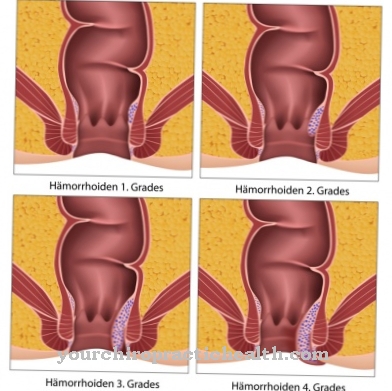At a Paraproteinemia is a condition in which so-called paraproteins are found in the blood. In particular, a special monoclonal immunoglobulin and corresponding immunoglobulin light chains are increasingly present in the blood.
What is Paraproteinemia?

© Gerhard Seybert - stock.adobe.com
Paraproteinemias are also known as monoclonal gammopathies. They describe the occurrence of a homogeneous immunoglobulin in human blood. In earlier times, paraproteinemia that was not associated with multiple myeloma or other clonal lymphoproliferative diseases was known as 'benign gammopathy' or 'benign paraproteinemia'.
However, the term 'monoclonal gammopathy of indefinite significance' has become established among medical professionals for these diseases in recent years. The abbreviation for this name is MGUS and it is used in many cases. MGUS is defined as a disease in which people have had monoclonal immunoglobulin in their urine or serum for a long period of time.
This immunoglobulin must be present in constant concentration and the disease must be asymptomatic. The monoclonal immunoglobulin forms in the bone marrow. Certain plasma cells, which proliferate slowly and do not show any malignant behavior, are responsible for the production of the substance. Very often the disease can only be diagnosed after a long observation period.
causes
Paraproteinemia is usually associated with various other diseases and symptoms. The causes for the occurrence of paraproteinemia also differ depending on the respective disease. In order to get a better overview of common clinical pictures and their causes, subgroups were formed.
These groups each refer to a protein whose concentration exceeds the normal value for various reasons. The subgroups usually refer to multiple myeloma, osteoclastic multiple myeloma, IgG deposition disease and Waldenström's disease. Other subgroups include monoclonal gammopathy of unknown significance and heavy chain disease. It should be noted that some of these diseases belong to the so-called non-Hodgkin lymphomas.
Symptoms, ailments & signs
The symptoms and symptoms of paraproteinemia manifest themselves in many ways and vary from patient to patient and depending on the underlying disease. A typical characteristic of paraproteinemia is, for example, the hyperviscosity of the blood.
The viscosity is more pronounced than usual due to the increased number of proteins in the blood. Further complaints are possible as a result of such hyperviscosity. These include, for example, neuropathies, amyloidosis and blood clotting disorders. In addition, so-called cold agglutinins are sometimes detected at the same time.
At the same time, in the context of paraproteinemia, there is a lack of normal immunoglobulins in many cases. This can lead to an increased susceptibility to infection in the affected person. In principle, it is a question of paraproteinemia if the plasma cell content in the bone marrow cells is higher than 30 percent.
The term paraproteinemia is also used when a tumor made up of plasma cells is detected in a tissue biopsy.
Diagnosis & course of disease
There are several options available to help you diagnose paraproteinemia. In principle, every detected paraproteinemia is to be regarded as a multiple myeloma or plasmacytoma until this suspicion is refuted.This makes it necessary to quantify the immunoglobulins both in the urine and in the serum.
In addition, the immune fixation must be analyzed. In addition, the blood count and especially the substances calcium and creatinine in the serum should be examined. As part of an X-ray examination, the spine, skull and pelvis, among other things, are shown graphically. In certain cases, an MRI scan of the spine is indicated.
A biopsy may be required for the bone marrow. Patients must undergo regular check-ups to continuously monitor the presence of paraproteins and other parameters. The bone marrow findings are often checked annually, especially in younger patients.
All pain that occurs in the musculoskeletal system should be examined using imaging techniques. Urine samples are particularly suitable for diagnosing paraproteinemia. Because here it is easy to determine if the protein content is too high. As soon as the concentration of certain proteins in the urine increases to more than one gram per 24 hours, paraproteinemia can be assumed.
Complications
Because of paraproteinemia, those affected can suffer from various ailments. As a rule, however, blood clotting disorders occur, so that the blood is very viscous. Furthermore, the patient's immune system is also significantly weakened, making them more susceptible to various infections and diseases. The patient's lymph nodes are often swollen in paraproteinemia and those affected feel sick and exhausted.
In the worst case, a tumor can also occur. If this remains undetected and is not treated, the person concerned will die in many cases. Paraproteinemia can be treated with chemotherapy or other drugs. However, there are various side effects that can have a very negative impact on the life of the person affected.
Radiation or stem cell transplantation can also reduce paraproteinemia. However, the tumor has to be removed by surgery. This may also reduce the life expectancy of the person affected. Furthermore, many patients are dependent on psychological treatment in the event of depression or other psychological problems.
Treatment & Therapy
In the case of paraproteinemia, the therapy of the respective symptoms is the main focus. The treating specialist decides on the therapeutic measures depending on the individual case. The aim is to eliminate the cause of the abnormal increase in protein. Various treatment options are available for this purpose.
These include, for example, chemotherapy, bisphosphonate treatment or immunomodulation. Radiation therapy, stem cell transplantation and surgical interventions are also possible. The protein-forming tumor is surgically removed.
The prognosis of the disease is based on various criteria. For example, if the amount of paraprotein increases continuously, this worsens the prognosis. In rare cases, the affected patients develop Waldenström's disease, malignant non-Hodgkin lymphoma, or amyloidosis.
You can find your medication here
➔ Medicines to strengthen the defense and immune systemOutlook & forecast
The prognosis for paraproteinemia depends heavily on the underlying disease that causes it. Most patients are diagnosed with chronic diseases that ultimately lead to changes in blood clotting. Since the underlying diseases often cannot be cured, the further prospect for the development of paraproteinemia is unfavorable. Rather, those affected need lifelong drug treatment in order not to trigger any acute health conditions.
In addition, secondary diseases are to be expected. In patients with paraproteinemia, there is often an increase in susceptibility to infections. The organism is weakened overall and can no longer react adequately to pathogens as usual. If the development is very unfavorable, the patient will develop a tumor. As a result, there is a potential risk to the expected life expectancy and coping with everyday life is severely restricted. Cancer therapy is necessary to alleviate the existing symptoms. Despite all efforts, in most patients the tumor disease ends in premature death.
When making a prognosis, it should also be taken into account that the emotional stress caused by the general state of health can result in subsequent psychological disorders. Overall, these also lead to difficult further development and can be very tedious. In most cases, this also leads to a further deterioration in physical health.
prevention
Concrete measures to prevent paraproteinemia are not known according to the current state of medical research. For this reason, a suitable specialist should be consulted at the slightest symptoms or signs of the disease. Because the earlier the diagnosis is made, the more favorable the prognosis for paraproteinemia is in some cases.
Aftercare
In the case of paraproteinemia, follow-up measures are very limited in most cases. The person affected should ideally consult a doctor early on so that there are no other complications and complaints for the person concerned. The earlier a doctor is consulted, the better the further course of the disease will usually be.
Most patients depend on the tumor to be removed. Bed rest should be maintained after surgery. Exertion or stressful and physical activities should be avoided in order not to unnecessarily burden the body. You should also have regular checks and examinations carried out by a doctor in order to quickly identify and remove further tumors.
It is not uncommon for the psychological support of one's own family to be very important, whereby especially loving and intensive discussions can have a positive effect on the further course of the illness. The further course of paraproteinemia depends to a large extent on the time of diagnosis, so that a general prediction is usually not possible. This disease may also limit the life expectancy of the person affected.
You can do that yourself
This diagnosis requires a thorough examination of the patient to determine what is causing the paraproteinemia. This underlying condition may be a tumor and should be treated appropriately. The check-ups that are due in the further course of the disease should also be observed and any additional physical complaints taken seriously.
Patients with paraproteinemia tend to feel tired and exhausted. In addition, there is an increased susceptibility to infection. An appropriate lifestyle is helpful in minimizing these symptoms. This lifestyle is made up of various components. On the one hand, there is the diet, which should consist of fresh ingredients and be rich in vitamins and fiber. Any excess weight should be reduced gently. In order to flush toxins out of the body, it is also advisable to drink a lot. Still mineral water, teas and thin juice spritzers have proven their worth here.
According to the latest research, a healthy diet also has a positive influence on any existing depression. Since paraproteinemia is a very stressful diagnosis, additional therapeutic concomitant therapy may be indicated. A paraproteinemia patient also benefits from a regulated sleep and wake rhythm. He should avoid alcohol and nicotine and instead take part in regular physical activity. Long walks in the forest or bike tours in the fresh air have proven their worth here.



.jpg)
.jpg)








.jpg)

.jpg)
.jpg)











.jpg)